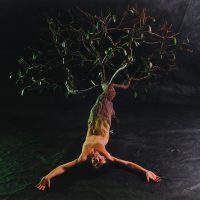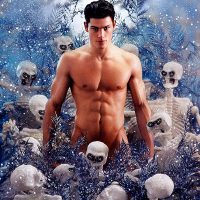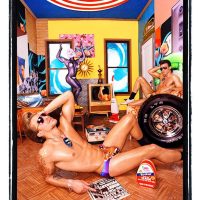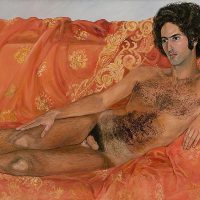Tibor Gyenis: Hommage á Ana Mendieta (from the series Hommage á Ana Mendieta), 1999. Courtesy of the Artist.
Pierre et Gilles: The Death of Adonis, 1999. Private collection, Paris
David LaChapelle: Celebrity Gleam, 2002. Courtesy of Galerie Thomas, Munich
Sylvia Sleigh: Imperial Nude: Paul Rosano, 1975. In private ownership, Florida, USA
The chronological starting point of the exhibition is the turn of the 19th and 20th centuries, when not even the traditional values of masculinity were spared by the crisis of identity, as manifested in the work of such artists of fin de siecle Vienna such as Egon Schiele and Oskar Kokoschka. For modern artists, the stripped down, naked male body was a bearer of revelation, self-knowledge and renewal. From this starting point, the exhibition follows the naked man through 20th and 21st century history, presenting challenges to the hegemonic model of male identity through the work of close to 100 artists, from questioning traditional male role models to the search for alternatives, from facing up to weakness and fragility to exploring the desiring gaze, body worship and the erotic pose.
In the depiction of the undressed male body there are also clues as to the changing social role of men, the formation of male identity, which is inseparable from both changes occurring in society and the workings of power. Power defines the gaze, which for centuries has been in the possession of men, while women have been merely the objects of the gaze. This division of roles between men and women in society was held to mirror the eternal or ‘natural’ order. The exhibition reassigns the roles, since the object of the gaze is no longer women, but men. How far this signifies the loss, sacrifice or transfer of possession of the gaze can be considered in depth with the help of thematically organised artworks.
The stripped down male body is defined by particular points of crisis. In that sense, the very spirit of the life reform movement that appeared at the turn of the century was one in which the naked male body was seen as a harmonious part of nature and a symbol of the desire to renew society. The naked man appears completely differently in relation to homosexuality. The homoerotic gaze eroticised the male body and examined it as an object of desire. The influence of feminism can be felt in artistic approaches that involve putting on make-up, the hiding of the sexual organ, as well as its ‘relocation’ or symbolic loss, all ways in which male artists have called attention to the arbitrariness of the designation of gender boundaries. Indefinable sexual identity, which is adaptive to the role of the opposite sex, is a revolutionary affront to the conventional expectations of traditional notions of masculinity and femininity. Heroic, hard masculinity, the healthy, body radiating physical strength, is a particularly important symbol for dictatorships. The disciplined body that conforms to the rules symbolises dominance over bodies. It is opposite to the anti-hero, the defenceless, vulnerable male body, that of the man who deliberately suffers pain in the desire to get back his lost power.
The man who belongs to a sexual or racial minority, along with the chubby or aging male, is forced out of public space and confined to the private sphere, cut off from the connection of the male body to power. The body symbolises power, which can only truly be possessed if its nakedness is not completely revealed, if the sexual organ remains hidden. One of the last taboos of the cultural sphere of Christianity is the sight of the male sexual organ. After all this, what remains an interesting question is whether the female gaze can be an instrument of power. In addition, how do we view the nude studies that were once an indispensible part of academic artistic training, along with earlier and more recent attempts at depicting naked male models? How do we see the relation between artist and model in the self-portrait, in which the artist uses his own naked body as a terrain for the merciless exploration of the self?
The new masculinity does not view cultural roles as naturally given, but rather revolts against them, smashing taboos and unveiling fetishes. In the region of Central and Eastern Europe the body of the naked man is enriched with further layers of significance. In the art of former socialist countries, the naked male body was seen as an expression of enslavement to the patriarchal system, while gender roles are also worthy of examination in this context. After the collapse of the system, the changed geopolitical order, old and new desires and power relations were inscribed onto the body, shaping the new masculinity.
Maayan Amir, Dieter Appelt, Christian Ludwig Attersee, Richard Avedon, Matthew Barney, Herbert Bayer, Irene Bayer, Mária Berhidi, Blue Noses Group, Saskia de Boer, Hermann Boll, Louise Bourgeois, Marianne Brandt, A. Calavas, Jimmy Caruso, Jean Cocteau, Edmund Collein, John Coplans, Marlene Dumas, Thomas Eakins, Frank Eugene, Atelier Fayer, Werner David Feist, Károly Ferenczy, Regina José Galindo, Gilbert & George, Felix González-Torres, Wilhelm von Gloeden, Tomislav Gotovac, Ion Grigorescu, Tibor Gyenis, Ilse Haider, Tibor Hajas, Károly Halász, Keith Haring, Erich Heckel, Matthias Herrmann, David Hockney, Anna Jermolaewa, Franz Kapfer, Zsolt Keserue, Jürgen Klauke, Max Koch, Oscar Kokoschka, Anton Kolig, Käthe Kollwitz, András Koncz, Rudolf Koppitz, Erzsébet Korb, Katarzyna Kozyra, Paul Kranzler, Elke Silvia Krystufek, Alfred Kubin, Hermann Werner Kubusch, Zofia Kulik, David LaChapelle, László Lakner, Peter Land, Annie Leibovitz, Zbigniew Libera, Herbert List, Heinz Loew, Urs Lüthi, János Major, Robert Mapplethorpe, Paul McCarthy, McDermott & McGough, Stefan Moses, Jan Mutsu, Eadweard Muybridge, Otto Mühl, Bruce Nauman, Atelier Alois Navratil, Adi Nes, Michael Neumüller, Oswald Oberhuber, Pablo Picasso, Pierre et Gilles, Guglielmo Plüschow, Bernhard Prinz, Arnulf Rainer, Leni Riefenstahl, Otto Rieth, Charlotte Rohrbach, Willy Römer, Egon Schiele, Joost Schmidt, Karl Schneider, Sascha Schneider, Rudolf Schwarzkogler, Ruti Sela, Fritz Simak, Sylvia Sleigh, Stelarc, Karl Sterrer, Baron Raimund von Stillfried, Róbert Szabó Benke, István Szőnyi, Lajos Tihanyi, Jan Toomik, Spencer Tunick, Béla Uitz, VALIE EXPORT, János Vaszary, Milisav Mio Vesović, János Vető, Bogdan Vladuta, Rudolf Wacker, Marianne von Werefkin, Edward Weston, Zelko Wiener, Artur Żmijewski



